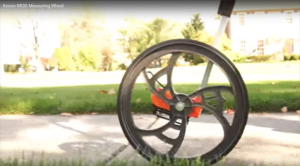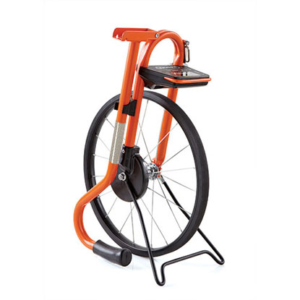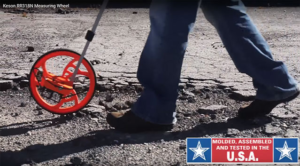Measuring Wheels: What Are They and How Are They Used

If you’re a builder, remodeler, Realtor or surveyor, then you’re probably used to taking measurements of large areas. And while you have many tools at your disposal to take those measurements with, there is one that will take measurements for you effortlessly while you walk.
The measuring wheel is one of the oldest measuring tools still used today. And while it isn’t right for every job, it makes measuring boundaries and large areas quick, effortless, and efficient. They come in several sizes and can be used in multiple applications to help you take fast, easy measurements as you walk.
Original Purpose
The measuring wheel has been in use for centuries. In fact, early reports date it back to the 1600s. The wheel itself hasn’t changed much in all this time, with the exception of comfort and accuracy.
The original purpose of the wheel was to estimate very long distances, particularly between cities and towns. This is how the wheel got the name of a surveyor’s wheel, although it’s also known as the clicking wheel, footage wheel and, sometimes, the distance calculation wheel.
Today’s wheels are used in much the same manner, but for a number of other purposes, such as marking the boundaries of a property, measuring the foundation of a house, measuring the distance between buildings on a property, marking off the edges of landscaping, determining the size of a garden and measuring the size of a long, flat area single handedly.
What Is a Measuring Wheel

Measuring wheels are very simple tools. At a minimum, they consist of a wheel attached to a long handle with a grip. As the wheel turns, it marks off the amount of times it rotates, quickly calculating distance. The flatter and smoother the surface that the measuring wheel is moved over, the more accurately it is able to determine distance.
Keep in mind that measuring wheels can only estimate flat distances: They cannot take elevations into account, and rolling them over rough or uneven terrain may make the final reading less reliable. However, if you simply need an estimate of distance, such as the rough number of feet between two outbuildings, this is an easy to use and read tool. The flatter the ground, the better the reading, as well, so if you’re walking the leveled ground around a foundation, you’ll find the tool to be fast and accurate.
Why Use a Measuring Wheel
There are many other tools that you can take measurements with and many of them will give you a more precise reading. The measuring wheel is still in use today for several simple reasons, however:
- You can use the wheel over long distances by yourself; you won’t need to help to hold a tape or to ensure it doesn’t move or shift.
- You can measure perimeters in one go, without needing to take separate measurements, simply by changing the position of the tool.
- There’s no end point to the wheel’s measurement, meaning that it won’t run out like a tape so you can cover longer distances.
- It’s easy to use; you can carry on conversations, take in your surroundings or stop to take notes on another subject while using the wheel.
- Some wheels can also mark an area by painting it as you roll, letting you measure and mark a boundary in one motion.
Using a Measuring Wheel

Using a measuring wheel is very simple. The first step is to find the right size for the job. Measuring wheels come in several sizes to better meet different purposes. This includes larger wheels for covering outdoor terrain and smaller wheels for indoor use, marking plumbing locations, measuring carpet and taking other interior dimensions.
Always make sure the wheel is clean and dry before you begin to ensure the best accuracy. Set it down at the exact point you want to begin measuring from. Most measuring wheels will have a handle or grip for maximum comfort. Take the handle, and begin walking at an even pace. Try to keep the pace consistent as you walk, as this will help ensure better accuracy.
Push the wheel along with you to the end point of the measurement, then lift the wheel straight up. This will prevent additional rotations of the wheel, which could interfere with its accuracy.
Retrieve your measurement from the wheel. If you are working across extremely long distances, you may also wish to use a string measure at the same time. This can help with better accuracy in the case of uneven terrain.
Take the Right Measurement
Measuring wheels are a quick, easy and efficient way to calculate or estimate long distances. They don’t require special knowledge or training to use and can help you get better results from your job. Check out Keson’s line of measuring wheels to find the right tool to aid you in your measurements.
